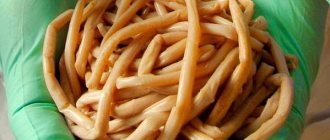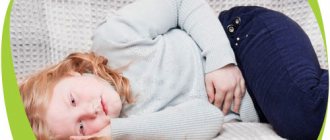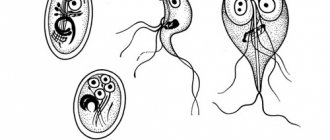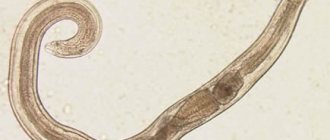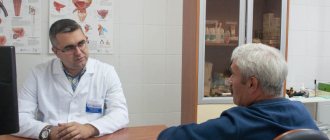Ways of infection with worms:
- contact with soil and water that contain parasite eggs (sandbox and puddle are no exception);
- consumption of foods that have not been properly processed - plant foods, meat, fish may contain worm eggs;
- neglect of hygiene;
- transmission of worms from mother to child during childbirth;
- regular contact with animals, especially street animals or those that go outside;
- visiting a room with insects;
- contacts with already infected children;
- low immunity;
- moving to another country, associated with stress on the body and incomplete acclimatization.
Based on the causes of the disease, it is not difficult to develop a system of minimal prevention - teach the child to wash his hands regularly, feed him only properly processed foods, and ensure sanitary control in the house. However, no one has canceled contacts with street animals and licking swings; the result is intestinal damage by parasites. Not all helminths immediately manifest themselves actively - they can remain dormant in the body for years, so regular checks, especially for children, are extremely important.
Classification of parasites
Different types of worms affect the body differently, and have their own characteristics both in the development cycle and in appearance and damage caused. There are three most common groups of worms: nematodes, cestodes, and trematodes.
The first group is the protocavitary worms. They live in soil and water, so they can easily become infected in the sandbox and during a walk in general. It is this group that includes the most common pinworms and roundworms, and also includes hookworms, trichinella, and guinea worms. Depending on which parasite caused the infection, ascariasis, enterobiasis, trichuriasis, etc. are distinguished.
Cestodoses are tapeworms that can live both in the intestines (the most common variant is tapeworms) and in organs (usually the larvae of tapeworms, echinococci, and alveococci live there). In accordance with which of these types of worms are found in children, echinococcosis, taeniasis, hymenolepiasis, etc. are distinguished.
And the last of the three popular groups is trematoses caused by trematodes. These are several types of flatworms - schistosome, cat/liver fluke, leukochloridium. They provoke opisthorchiasis (transmitted from fish of the carp family) and fascioliasis (the liver and bile system suffer, infection through plants or water).
Note to moms
Category: Useful information.
Be careful………WORMS!!!!!!
Worms
is a group of worms that parasitize the human body. And what we colloquially call worms, doctors call them differently - helminths. In the European part of Russia, roundworms and pinworms are most often found, parasitizing in the intestinal lumen.
Roundworms are long round (up to 10–15 cm) worms with pointed ends, white or translucent. If no special treatment is carried out, they can live in the human body for years.
Pinworms are very small (up to 1 cm), whitish-colored worms. They live in the lower intestines, so they can easily be seen in stool. The disease caused by pinworms is called enterobiasis.
Helminths live only a month, but during this time they manage to lay a lot of eggs, and therefore their numbers are constantly increasing. According to statistics, about 80% of children suffer from helminthic infestations from time to time and about 25% of the total population of the planet is infected with one form or another of worms.
How and where can a baby become infected with worms and why are babies most susceptible to their appearance?
There are 4 main sources of parasite eggs entering the body:
1. Through soil and water
. After any contact with the ground, sand, the child should not just wash his hands, but thoroughly clean his nails, and it is better that the baby has them cut short. Food products that grow in the ground - vegetables, herbs, fruits, berries, mushrooms, everything connected to the ground requires thorough washing under running water and scalding with boiling water. Pets, primarily dogs or cats, walking on the street, bring a lot of sewage into the house, and children playing with them are at maximum risk of infection; an animal can easily infect a child with any type of worms. Flies are also the main carriers of helminths, being in public toilets, places where agricultural livestock live, the flies then calmly land on food, spreading eggs on their wings and paws. A huge number of worm eggs end up in open water bodies and well water. Therefore, those who live in rural areas or in the country should use a bactericidal filter and be sure to boil water; there is also a danger of a child swallowing water when swimming in open water.
2. Pinworms are transmitted from person to person
, this is the highest risk of infection. Infection of others occurs very easily. When a female pinworm crawls out of the intestines at night, she lays eggs near the anus, which causes severe itching; the child, scratching the itchy area, infests their hands, nails, panties, and bed linen with them. Without washing his hands right away, hundreds of eggs remain on all objects he touches - door handles, clothes, food, toys. Further, the infection process is clear; eggs also settle on the hands of another child or adult using these items, and without washing their hands before eating, they end up in the mouth of a healthy person.
3. When eating raw, semi-raw or lightly cooked meat
(pork, beef) or fish infected with helminths (sushi, kebab, dried fish, lard with streaks of meat, etc.)
4. Some parasites enter the body through insect bites
Worms are mainly a problem for children. Firstly, because they are most susceptible to the development of helminthiases, since the protective barriers in the children's body are not properly formed, the acidity of the stomach is lower than in an adult. Secondly, preschool children, mastering the world, touch all surrounding objects not only with their hands, but also taste them. And parents, with all their desire, can teach their child to strictly follow the rules of personal hygiene, without reminders, only by the age of 3–6, which exposes not only the baby himself, but also all family members, to the risk of infection (pinworms).
How to understand that there are... worms and by what symptoms can a mother suspect that something is wrong with the child?
The baby develops profuse salivation, bad breath, nausea for no reason, sometimes vomiting, the child becomes weak, lethargic, complains of headaches, gets tired quickly, is pale, and has blue under the eyes.
The appetite also changes - the baby does not eat anything, refuses his favorite dishes, or begins to ask for something that he has never wanted before. The appetite may increase, and then the child will constantly ask for food. Sometimes cramping pain in the abdomen and bowel disorders (diarrhea or constipation) appear.
Worms lead to allergization of the body, and then manifestations of atopic dermatitis are observed on the baby’s skin. Corns may form on the soles of your feet. Moreover, such skin symptoms are practically impossible to overcome while the helminths remain in the body. With some helminthic infestations, for example enterobiasis, the child becomes hyperexcitable in the evenings, capricious, may have difficulty falling asleep at night, toss and turn, worry, cannot find a place for himself, fidgets a lot to choose a comfortable position for sleeping, etc. And the baby will sleep superficial. You should also be wary if your child has redness and scratching in the anus area. In girls, enterobiasis is sometimes accompanied by inflammation of the external genitalia - pinworms carry various protozoa and fungi from the intestines.
When and why should you see a doctor at the clinic?
Some children may not have any complaints at all, but the worms still slowly poison and weaken the child’s body. Therefore, if you notice at least one of the listed signs in a child, and your baby often comes into contact with animals, plays on the ground or in open sandboxes, is accustomed to putting things in his mouth, biting his nails or licking his fingers, you need to contact the clinic, as there is a risk his infection is very high. The pediatrician will prescribe examination and treatment.
To increase reliability, a stool test will have to be taken for at least three consecutive days. When you suspect pinworms, carefully examine the contents of your baby's potty - you can see live parasites in the feces with the naked eye.
If the results of the analysis make it clear that the child is infected, special therapy must be carried out immediately.
The insidiousness of helminthic infestation is that if someone in the family (no matter an adult or a child) has helminths, infection begins in a circle. Therefore, all family members (and pets too!) should be treated immediately. In addition, it is necessary to increase attention to hygiene. Wash the floor in the apartment and in the staircase with a weak chlorine solution. Be sure to boil and iron bedding and clothing on both sides.
The sooner treatment is started, the better. But, under no circumstances should you self-medicate! Antihelminthic drugs and dosage should be selected and prescribed only by a doctor. Many drugs in large doses are poisonous to the child's body and have serious side effects. Therefore, do not endanger your child’s health, but consult a specialist.
District pediatrician Potapova M.P.
Print Email
Symptoms
There are a lot of symptoms, and individual manifestations depend on which helminth eggs have entered the body. Next, we will talk about the general symptoms for all parasitic infections, and then about enterobiasis, ascariasis and 5 other types of infections.
General symptoms:
- increased irritability, restless sleep, decreased perseverance and attentiveness, frequent hysterics and anger;
- increased appetite associated with active weight loss;
- symptoms from the digestive system - diarrhea, constipation, nausea, pain in the right hypochondrium;
- dizziness and headache;
- food allergies;
- nasal discharge;
- diseases and infections of the reproductive system;
- brittle nails/hair;
Enterobiasis is a helminthiasis in which the body is infected by pinworms. The larvae emerge from the eggs within 4-6 hours; in 2-4 weeks they become adults - grayish or white roundworms 5-10 mm long. They settle in the cecum and appendix, and lay eggs outside the anus - at night, female pinworms come out into the air for this purpose. This reproduction mechanism leads to severe itching at night - hence restless sleep, tossing and turning, and screaming.
Additional special symptoms:
- night urination;
- grinding teeth;
Ascariasis is a helminthiasis in which the body is colonized by roundworms. These worms are already larger - the average length of an adult is 25-30 cm. The larvae and eggs enter the body with insufficiently disinfected fresh fruits and vegetables. The development period takes place in the intestines, after which they pass into the lymphatic and blood vessels, and with the flow of blood and lymph they are distributed throughout the body - in the liver, heart, lungs. They then enter the oral cavity and are re-swallowed. From this moment, adult roundworms begin to develop. This takes approximately 3 months.
How to suspect the presence of worms in children:
- the liver, spleen, lymph nodes enlarge;
- the temperature rises, sometimes up to 38 degrees;
- malaise and weakness appear;
- respiratory pathologies develop - pneumonia, bronchitis and bronchial asthma;
- pressure drops;
- Gastrointestinal symptoms appear - constipation, diarrhea, nausea and vomiting, pain in the form of contractions;
- fear of light;
- nightmares at night;
- dry cough - sputum with an orange tint and bloody spots.
It is more difficult to breed roundworms than pinworms, since the female lays almost 250 thousand eggs every day. In no case should you rely on traditional methods or buy the first remedy you come across at the pharmacy - be sure to contact a specialist.
These are not all worms in children that inhabit the body. There are more than 300 species of helminths in the world, and 70 of them are found in Russia alone. In addition to the two listed types, 5 more types are becoming widespread:
- trichocephalosis - characterized by a lag in both physical and intellectual development, but in general it is almost asymptomatic;
- opisthorchiasis – the temperature rises, the nodes of the lymphatic system enlarge, skin rashes appear;
- hymenolepiasis – the main consequence is rhinitis;
- toxocariasis - has many symptoms that distinguish it from other helminth infections: keratitis, cough with suffocation, ophthalmitis, chorioretinitis, facial swelling;
- wide tapeworm - characterized by anemia, intestinal disorders, pain in the abdominal area.
Infants may experience symptoms after just a few weeks of life if they have received the eggs and larvae of worms from their mother, for example during childbirth. As a rule, symptoms manifest themselves in the form of lack of weight gain, excessive drooling, rash, pallor, blue under the eyes, constipation. The child is constantly worried, screams, sleeps and eats poorly. The screaming can be unbearable and the baby will turn blue in the process.
Worms are often the cause of the development of pulmonary pathologies and are diagnosed using ultrasound or x-ray. Parasites, in particular Echinococcus tapeworm, can damage not only the respiratory system, but also move further to the brain and heart. In areas where helminths develop in the lungs, scars and adhesions appear, and the shape of the lungs begins to change. Such changes provoke a wide range of diseases - asthma, fibrosis, bronchitis, pleurisy, emphysema, etc. When a tapeworm enters the lungs, echinococcosis is formed, when the parasite develops in the form of a cyst.
Symptoms will largely depend on which helminth has entered the body, but the child’s anxiety and the presence of the above general symptoms should alert parents. If signs of worms appear, make an appointment with a pediatrician or gastroenterologist to get tested in a timely manner.
Symptoms of worms
There are two forms of helminthiasis with their inherent manifestations: acute and chronic.
In acute helminthiasis, worms enter the body and provoke an immediate immune response in the form of allergic reactions (in connection with this, parents often confuse the presence of parasites with ordinary allergies). Manifestations of chronic helminthiasis can be very diverse. The clinical picture depends on the location of the parasites, their number and the specificity of the body's response to the presence of helminths.
Let us highlight the most characteristic symptoms and indirect signs of the presence of worms in a child:
- general malaise, weakness, fatigue;
- increased body temperature;
- dark circles under the eyes;
- allergic reactions in the form of skin rash (urticaria);
- problems with appetite;
- nausea and vomiting;
- smell from the mouth;
- pain in the abdominal cavity;
- bowel disorders (constipation/diarrhea);
- weight loss;
- itching in the anus;
- excretion of worm fragments in feces.
In addition to these symptoms, children and adolescents may show signs of dysfunction of organs affected by worms. Thus, if the liver is damaged, pain in the right side under the ribs, nausea, and jaundice of the skin may occur. If the lungs are damaged, asphyxia of the respiratory tract, etc. may occur. Children suffering from helminthic infestations are among the most frequently ill. Such children are susceptible to the frequent occurrence of ARVI, stomatitis, gingivitis, vulvovaginitis (girls), etc.
Diagnostics
Diagnosis of worms in children is carried out in different ways - depending on what worms the child is infected with, the habitat, location of the eggs, and toxins found in the body will differ.
To make a diagnosis, the following may be prescribed:
- blood test - shows anemia, hemoglobin and eosinophil levels;
- analysis for parasites - in 99% of cases it helps to detect helminthiasis, and in most cases it helps to accurately determine the type (biomaterial for research - blood from a vein);
- examination of stool - there may not be eggs in the stool, even if there is an infection, to ensure the presence of worms, this diagnosis should be carried out 3 times, which takes time;
- smear - especially effective in case of pinworm infection, since their eggs are found just outside the anus;
- stool analysis for dysbacteriosis;
- if there is a suspicion of infection of internal organs, and not just the gastrointestinal tract - CT, X-ray, ultrasound.
Diagnostics allows you to accurately identify the type of parasite and prescribe specific treatment. The doctor prescribes medications, diet, additional supportive procedures, and gives recommendations for care and hygiene.
In some cases, parents pay increased attention to helminthiasis and are constantly worried about infecting their child. This leads to regular “preventive” courses of serious anthelmintic drugs, which do not bring any benefits to the baby’s body. If your child is not losing weight, feels well, eats well, has a healthy complexion, and does not have itching in the anal area, he is likely healthy. If you want to make sure of this, it is better to get tested than to take an unnecessary course.
Types of worms in children
The most common classification of helminthic infestations is depending on the type of pathogen. The following groups of parasites are distinguished:
- nematodes (roundworms): these include roundworms (actually, worms), pinworms, whipworms;
- cestodes (tapeworms): broad tapeworm, pork tapeworm;
- trematodes (flukes): cat fluke, pulmonary and liver flukes and others.
Depending on the characteristics of the life cycle of worms, there are three main types of helminthiasis:
- contact (damage from pinworms, dwarf tapeworm): parasite eggs are transmitted from child to child through dirty hands, household items, etc.;
- geohelminthiasis (infection with roundworms, hookworms, etc.): worm eggs are found in the ground and enter the body when eating unwashed vegetables and fruits, or not following hygiene rules;
- biohelminthiasis (infection with bovine, pork tapeworm, echinococcus): intermediate forms of development of the parasite are found in the body of carriers (fish, shellfish, dogs, etc.), enter the body by eating contaminated meat or by contact.
Treatment
The course of therapy for worms in children includes several stages - preparation, therapy and cleansing. During the entire treatment, it is necessary to carry out general preventative measures and carefully observe hygiene to avoid re-infection or infection of one of the family members. Some types of worms, such as tapeworms and echinococci, can only be removed surgically.
The preparatory stage involves taking sorbents - Smecta, Entegnin, which absorb toxins and cleanse the body. They are followed by antihistamines, they relieve general itching and prevent the development of allergic reactions to drugs.
Treatment of helminthiasis in children at the main stage is directly taking anthelmintic drugs in the form of tablets, suppositories or suspensions. Medicines are selected depending on the type of helminth, individual indications and contraindications. Some anthelmintics work in 2 doses:
- the first course kills already developed individuals;
- the second course helps to cope with larvae and eggs (prescribed 2 weeks after the first).
Cleansing is designed to rid the body of the remnants of dead parasites; at this stage, sorbents, enemas, and choleretic drugs are used. You can help your baby by adding raw carrots, dairy products, coarse bread, fruits, vegetables, fish oil, nuts, especially walnuts and peanuts to the diet.
Additionally, to restore the body in case of serious damage, vitamin complexes, iron, minerals, and a special diet can be used, which will increase hemoglobin, restore liver function and strengthen the body as a whole. The doctor describes the treatment plan in detail, avoiding side effects. Control tests are required. Self-medication and deviation from the plan are not allowed.
Causes of worms in children
The main reason for the incidence of helminths is the widespread prevalence of parasite larvae and eggs in the child’s environment and non-compliance with personal hygiene rules. The method of spreading parasitic infection is fecal-oral. Helminth eggs are shed in the feces of infected people and animals.
After using the toilet, worm eggs may remain on the skin of the hands, under the nails or on the underwear. Most often, children become infected in places where large numbers of people gather (in kindergartens, schools, playgrounds). Infection occurs through sharing toys, sports equipment, etc.
In addition, the following reasons for the development of helminthic infestation are identified:
- consumption of poor-quality water and food contaminated with helminth eggs;
- use of other people's personal items (towels, linen);
- poor processing of vegetables and fruits;
- close contacts of the child with domestic and street animals.
The high incidence of helminthiasis infection in early childhood is due to the exploratory instinct of a small child. Until 2 years of age, the main form of cognition of the surrounding reality is oral. The kids are trying to get their teeth into all the subjects. That is why it is important for parents to pay special attention to the cleanliness of objects and things surrounding the child.
Consequences of untreated parasitic infestations
Helminthiasis poses a serious danger; without treatment, it can result in death or significant health problems. An infected child poses a danger to the entire family and environment, as it spreads the disease.
Complications of worms in children:
- inflammatory exacerbation of appendicitis;
- epileptic seizures;
- visual impairment of several types;
- allergic reactions with copious nasal discharge;
- developmental lag behind peers;
- sexually transmitted infections, the most common in girls is vulvovaginitis;
- various types of pulmonary manifestations, including bronchial asthma;
- in difficult cases - damage to the brain and heart.
Diagnosis of worms
If any symptoms indicate that your child may have worms, it is important to immediately go to the doctor.
Due to the nonspecific symptoms of helminthiasis, parents often turn to various specialists (pulmonologists, allergists, immunologists, etc.), suspecting serious illnesses in the child. However, the cause of the symptoms that arise can often lie in the body being damaged by parasites. That is why children with chronic dermatitis, gastroenterological pathologies and pulmonary diseases, frequent vulvovaginitis in girls, must be examined for the presence of helminths. Since helminths usually predominate in the intestines, in order to identify helminthic infestation, the patient is first referred for a stool examination. The analysis will help identify the presence of parasites in the child’s gastrointestinal tract, as well as determine the type of worm that has penetrated.
In addition, the following methods for diagnosing helminthiasis can be used:
- general blood analysis;
- radiography;
- Ultrasound;
- MRI;
- CT;
- endoscopy with biopsy.
The main task of diagnostic measures is to confirm the presence of helminths in the body, determine their type and exact location. In accordance with the research data obtained, doctors select the most appropriate treatment for a particular case.
Prevention
To ensure that treatment of worms in children is not required at all, it is necessary to actively engage in prevention, which consists of both daily precautions and hygiene procedures, as well as taking medications.
How to protect your baby from parasitic infection:
- Maintain hygiene – regularly wash your child’s hands and bathe him;
- regularly care for toys - washing and cleaning (after diagnosis, all toys must be disinfected);
- cut your nails as often as possible, clean them every day;
- iron clothes after washing;
- get rid of bad habits - sucking fingers, pens, biting nails;
- give only boiled water to drink and explain the reasons;
- avoid swimming in natural bodies of water;
- use repellents (insects often carry worm eggs), destroy all insects that enter the house;
- regularly check pets for parasites;
- Wash fruits and vegetables thoroughly, conduct sufficient heat treatment of meat and fish.
Some types of helminthiases are difficult to cure, so we recommend preventive measures to avoid infection. When contacting the clinic, parents will receive full advice on how to properly carry out prevention to avoid problems in the future.
Preventive actions
Preventing worms in children is a simple matter and does not require any special knowledge. Parents just have to follow some rules:
- before each meal, the child should wash his hands thoroughly with soap and hot water;
- Nail cutting should be done regularly;
- A small child needs to change his underwear regularly, preventing it from getting too dirty;
- in rooms where children most often play, it is necessary to regularly do wet cleaning;
- It is extremely undesirable to have a pet in the house/apartment while the child is small;
- Once a year, the whole family should take prophylactic antihelminthic medications, but only after consulting a doctor.
Worms in children are a rather unpleasant fact that you can get rid of quickly and without any problems. Parents only need to pay attention in time to the deterioration of the child’s health and seek qualified medical help, and not self-medicate.
Related services: Consultation with a pediatrician Hotline “DobroMama” 0 800 302 888
Make an appointment
The clinic offers the services of an experienced gastroenterologist, candidate or doctor of medical sciences, who will make a preliminary diagnosis, prescribe only the necessary studies according to the results of the examination, and write out a treatment plan. Having our own laboratory allows us to quickly obtain tests, and the absence of queues and appointments by appointment allows us to prescribe treatment as soon as possible. To make an appointment, select the doctor you like and fill out the form on the website, use the general appointment form, the function to order a call back, or simply call our contact center.
Prevention of worm infection
It is quite possible to prevent a baby from becoming infected with worms, but this will require considerable effort, in particular, the following will give a good effect:
- frequent wet cleaning of the house using disinfectants,
- systematic washing of toys and household items with which children have direct contact,
- systematic replacement of bed linen, washing it thoroughly and mandatory ironing on both sides.
Parents should not forget that the greatest danger for a child is infection with worms in infancy. Therefore, maintaining perfect cleanliness of strollers, playpens and cribs is simply necessary.
Compliance with hygiene rules by people caring for a child is mandatory! It is undesirable for a child to have direct contact with pets, for him to crawl near the front door, or to touch the shoes he wears on the street. As the child grows up, the rules of hygiene should be taught; even basic hand washing after visiting the toilet or walking outside will significantly reduce the risk of helminth infection.
Why is helminthic infestation dangerous in children?
In addition to general intoxication and discomfort, a parasitic infection is fraught with many negative consequences for a growing organism:
- development of many allergic reactions;
- tendency to bronchial asthma;
- decreased immunity;
- diseases of the gastrointestinal tract, worms damage the intestinal walls and can cause the onset of an inflammatory process or even cause obstruction.
If you notice the first symptoms of a helminthic infestation in your baby, it is recommended to immediately contact the children's clinic and receive a referral to undergo the appropriate tests. Based on their results, the doctor will prescribe treatment.
Folk remedies against worms
Admittedly, folk remedies are the most suitable for treating helminthic infestations in children; the symptoms recede quite quickly. However, before using them, you must definitely consult a doctor, because the child’s body is very vulnerable not only to the action of parasites, but also to the inept use of medicines, even folk ones. When preparing medications at home, it is difficult to maintain the correct recipe and dosage; at best, an incorrectly prepared drug can be simply useless, at worst, it can lead to poisoning or an allergic reaction. Here are the most popular folk anthelmintic remedies:
- Garlic enema. Garlic is an antiseptic given to humans by nature; it is also applicable against worms. A glass of cow's milk is mixed with one head of chopped garlic, the mixture is boiled, then cooled and filtered through a double layer of gauze. At night, the child is given an enema from the milk received, a third of the received drug is taken for it, and the child is treated in this way for at least a week.
- Chamomile decoction. Another natural antiseptic that is used to treat a wide variety of diseases. To prepare the decoction, take a tablespoon of dry chamomile herb and pour boiling water over it, leave until it cools, and give the child to drink throughout the day instead of water or tea. Duration of treatment is 5 days.
- Onion remedy. Chop a small onion, add milk and boil the resulting mixture, then cool and filter. The resulting product is given to the baby for three days in a row, 100 ml.
Simple folk recipes that will help cure a child of worms, watch the video:
